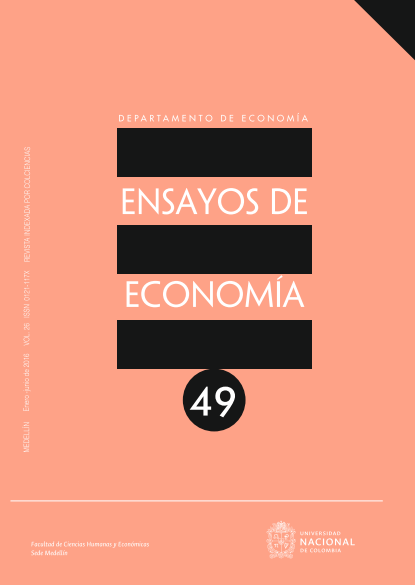Crecimiento económico colombiano y quiebres estructurales endógenos
Colombian economic growth and endogenous structural breaks
La croissance économique colombienne et ruptures structurelles endogènes
DOI:
https://doi.org/10.15446/ede.v26n49.63659Palabras clave:
Crecimiento económico, PIB, quiebre estructural, apertura económica. (es)Economic growth, GDP, structural change (en)
Croissance économique, PIB, changement structurel (fr)
Descargas
Este documento explora mediante pruebas de cambio estructural endógeno, posibles quiebres en
la distribución no condicional del crecimiento del PIB real colombiano entre 1924 y 2013. No se
encuentra evidencia de algún quiebre estructural en la tasa de crecimiento económico durante el
periodo analizado, contradiciendo previos hallazgos de la literatura académica colombiana. Para la
serie en niveles del logaritmo del PIB real se obtiene evidencia de tres cambios estructurales en la
tendencia, en los años 1942, 1972 y 1999. El último podría asociarse con reformas económicas,
en términos de apertura de las cuentas real y financiera de la economía colombiana. Se comparan
las estimaciones con la situación para otros 16 países de la región. En este caso, a diferencia del
colombiano, los resultados apuntan a la presencia de quiebres a finales de la década de los 70,
durante la década de los 80, y a principios de los 90 para algunos países de la región.
2013. We do not find evidence supporting a change in the economic growth rate during the sample,
as stated by some previous theoretical and empirical studies for the Colombian case. Nevertheless,
we find evidence of breaks in the PIB trend in 1942, 1972 and 1999. The latter can be related to
structural reforms implemented in the Colombian economy, in terms of commercial and financial
liberalization. We compare our main results with estimations for other 16 countries of the Latin
American region. Unlike the Colombian case, other Latin American economies do house structural
breaks at the end of the 70s, during the 80s and at the beginning of the 90s
réel de 1924 à 2013. Nous ne trouvons pas de preuves à l’appui d’un changement dans le taux de
croissance économique au cours de l’échantillon, comme l’indiquent certaines études théoriques
et empiriques précédentes pour le cas colombien. Néanmoins, on constate des ruptures dans la
tendance PIB en 1942, 1972 et 1999. Ces dernières peuvent être liées aux réformes structurelles
mises en œuvre dans l’économie colombienne, en termes de libéralisation commerciale et
financière. Nous comparons nos principaux résultats avec les estimations pour les 16 autres
pays de la région Amérique latine. Contrairement au cas colombien, d’autres économies latinoaméricaines abritent des ruptures structurelles à la fin des années 70, au cours des années 80 et
au début des années 90.
Referencias
Bai, J. (1997b). Estimation of a Change Piont in Multiple Regression Models, The Review of Economics and Statistics, 79(4), 551-563.
Bai, J., & Perron, P. (1998).Estimating and Testing Linear Models with Multiple Structural Change. Econometrica,1(66), 47-78.
Bai, J., & Perron, P. (2003). Computation and Analysis of Multiple Structural Change Models. Journal of Applied Econometrics, 18(1), 1-22.
Ben-David, D., & Papell, D.H. (1998). Slowdowns and Meltdowns: Postwar Growth Evidence from 74 Countries. Review of Economics and Statistics, 80(4), 561-571.
Cárdenas, M. (2007). Economic Growth in Colombia: a Reversal of ‘Fortune’? Ensayos sobre Política Económica, 25(53), 220-258.
Chow, G. C. (1960). Tests of Equality Between Sets of Coefficients in Two Linear Regressions. Econometrica, 28(3), 591–605.
Dickey, D. A., & Fuller, W. A. (1979). Distribution of the Estimators for Autoregressive Time Series With a Unit Root. Journal of the American Statistical Association, 74(366), 427–431.
Enders, W. (2010). Applied Econometric Time Series, 3rd Edition. Nueva York, Estados Unidos: John Wiley & Sons, Inc.
García, J. G. (2002). Liberalización, Cambio Estructural y Crecimiento Económico En Colombia. Cuadernos de economía, 21(36), 189-244.
Gebregziabher, F. (2015). Adjustment and Long-Run Economics Performance in 18 African Countries. Journal of International Development, 27(2), 170-196.
Hansen, B.E. (1997). Approximate Asymptotic P Values for Structural-Change Tests. Journal of Business and Economic Statistics, 15(1), 60–67.
Hansen, B.E. (2001). The New Econometrics of Structural Change: Dating Breaks in U.S. Labor Productivity. Journal of Economic Perspectives,15(4), 117-128.
Hausmann, R., Pritchett, L., & Rodrik, D. (2005). Growth Accelerations. Journal of Economic Growth, 10(4), 303-329.
Kwiatkowski, D., Phillips, P. C. B., Schmidt, P., & Shin, Y. (1992). Testing the Null Hypothesis of Stationarity Against the Alternative of a Unit Root: How Sure Are We that Economic Time Series Have a Unit Root ?. Journal of Econometrics, 54(1-3), 159–178.
McConnell, M., & Perez-Quiros, G. (2000). Output Fluctuations in United States:What Has Changed Since the Early 1980s?. American Economic Review, 90(5), 1464-76.
Ortiz, C.H. (2009). La Desaceleración Económica Colombiana: Se Cosecha lo que se Siembra. Revista de Economía Institucional, 11(21), 107–137.
Ortiz, C.H. (2015). Política y Crecimiento Económico en Colombia 1906-2009. Revista de Economía Institucional, 17(32), 195–222.
Ortiz, C.H., Uribe, J.I. & Vivas, H. (2009). Transformación Industrial, Autonomía Tecnológica y Crecimiento Económico: Colombia 1925-2005 (352). Departamento Nacional de Planeación. Recuperado de https://colaboracion.dnp.gov.co/CDT/Estudios%20Econmicos/352.pdf
Perron, P., & Zhu, X. (2005). Structural Breaks with Deterministic and Stochastic Trends. Journal of Econometrics, 129(1-2), 65–119.
Perron, P. (2006). Dealing with a Structural Breaks, The Palgrave Handbook of Econometrics: Volume 1: Econometric Theory.
Phillips, C.B., & Hansen, B. (1990). Statistical Inference in Instrumental varia- bles Regression with I (1) Processes. The Review of Economic Studies, 57(1), 99-125.
Quandt, R. E. (1958). The Estimation of the Parameters of a Linear Regression System Obeying two Separate Regimes. Journal of the American Statistical Association, 53(284), 873–880.
Quandt, R. E. (1960). Tests of the Hypothesis that a Linear Regression Obeys Two Separate Regimes. Journal of the American Statistical Association, 55(290), 324–330.
Said, S. E., & Dickey, D. A. (1984). Testing for Unit Roots in Autoregressive-Moving Average Models of Unknown Order, Biometrica, 71(3), 599–607.
Stock, J., & Watson, M. (1988). Testing for Common Trends. Journal of the American Statistical Association, 83(404), 1097-1107.
Cómo citar
APA
ACM
ACS
ABNT
Chicago
Harvard
IEEE
MLA
Turabian
Vancouver
Descargar cita
Licencia
Derechos de autor 2016 Ensayos de Economía

Esta obra está bajo una licencia internacional Creative Commons Atribución-NoComercial-SinDerivadas 4.0.
Se autoriza la reproducción sin ánimo de lucro de los materiales, citando la fuente.



























